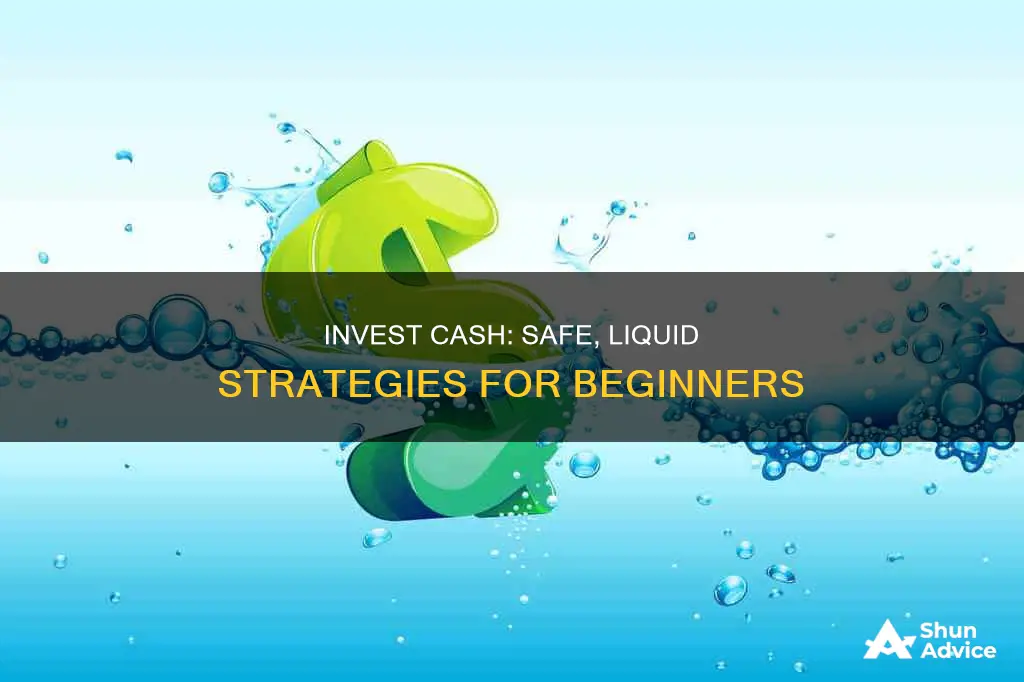
Investing your cash in liquid assets is a great way to build wealth while keeping your funds easily accessible. Liquidity is one of the most important metrics of any asset, along with profitability and risk. Liquid assets can be converted into cash quickly and easily, without losing value, and are ideal for emergency funds or short-term financial goals.
There are several types of liquid investments, including cash, high-yield savings accounts, money market accounts, certificates of deposit (CDs), bonds, stocks, mutual funds, and exchange-traded funds (ETFs). These investments vary in terms of liquidity, risk, and potential returns, so it's important to understand the characteristics of each before deciding where to put your money.
For example, cash is the most liquid asset, but it doesn't earn any interest, so it may be difficult to keep up with inflation. On the other hand, investments like high-yield savings accounts and money market accounts offer higher interest rates but may have restrictions on withdrawals.
When investing in liquid assets, it's crucial to diversify your portfolio to balance risk and return. Additionally, consider your financial goals and time horizon. If you need access to your money in the short term, liquid investments are a safer option than long-term investments like stocks, which tend to be more volatile.
By choosing the right mix of liquid investments, you can ensure that your money remains accessible while also growing steadily to meet your financial goals.
| Characteristics | Values |
|---|---|
| Timeframe | Less than three years |
| Risk | Low |
| Accessibility | High |
| Returns | Low |
| Demand | High |
| Market | Established |
| Buyers | Large number |
| Transferability | Easy and secure |
What You'll Learn

High-yield savings accounts
You can typically earn much higher interest rates at online banks than at national, brick-and-mortar banks. Plus, you can usually access the money by quickly transferring it to your primary bank or maybe even via an ATM.
- Barclays Tiered Savings Account: 4.50% APY for $0 to <$250k; 4.80% APY for $250k+ balance
- SoFi Checking and Savings: 4.20% APY with direct deposit or $5,000 or more in deposits every 30 days; 1.20% APY without
- CIT Bank Platinum Savings: 4.55% APY with $5,000 minimum balance
- Openbank High Yield Savings: 5.00% APY with $500 minimum balance
- UFB Portfolio Savings: 4.31% APY with $0 minimum balance
- American Express High Yield Savings Account: 4.00% APY with $0 minimum balance
- Capital One 360 Performance Savings: 3.90% APY with $0 minimum balance
- EverBank Performance Savings: 4.75% APY with $0 minimum balance
Cash Investments: What Are They?
You may want to see also

Money market accounts
While money market accounts offer higher interest rates than savings accounts, they may have minimum balance requirements and limitations on the number of monthly withdrawals. It's important to consider these restrictions when deciding if a money market account is the right choice for your financial needs.
Investing in Cash Balance Plans: Understanding Your Options
You may want to see also

No-penalty certificates of deposit
A no-penalty CD is a type of certificate of deposit that does not charge a fee for withdrawing money before the term expires. It offers more flexibility than traditional CDs, which often have penalties for early withdrawals. With a no-penalty CD, you can withdraw your funds early without incurring a financial penalty, usually about a week after funding the account. However, partial withdrawals are generally not allowed, and you may need to withdraw the entire balance.
Pros of No-Penalty CDs:
- No early withdrawal penalty: You can access your money without paying a fee, which is especially useful if you need funds unexpectedly.
- Competitive interest rates: No-penalty CDs typically offer higher interest rates than regular savings accounts, helping your savings grow faster.
- Opportunity to take advantage of rising rates: If your financial institution increases rates, you can withdraw your funds from the no-penalty CD and move them to a higher-yielding account without penalty.
Cons of No-Penalty CDs:
- Lower interest rates than traditional CDs: You may find higher interest rates with traditional CDs, which have a penalty for early withdrawals.
- Limited term lengths: No-penalty CDs usually have shorter term lengths than traditional CDs, and you may need to withdraw your funds within a specific timeframe.
- No partial withdrawals: Most no-penalty CDs do not allow partial withdrawals. If you need to access your funds, you will likely need to withdraw the entire balance and close the account.
When to Choose a No-Penalty CD:
No-penalty CDs are ideal for individuals who want to build savings but also want the flexibility to make withdrawals for unexpected expenses. They are a good choice if you are unsure about your need for liquidity and want to avoid early withdrawal penalties.
Where to Find No-Penalty CDs:
No-penalty CDs are offered by various financial institutions, including online banks, credit unions, and traditional brick-and-mortar banks. When looking for the best rates, consider comparing offers from online banks and credit unions, as they often provide more competitive rates than larger institutions. Additionally, longer-term no-penalty CDs may offer higher interest rates, so consider your savings goals and time horizon when choosing a term length.
Investing Cash During Inflation: Strategies for Success
You may want to see also

Short-term government bond funds
Short-term US government bond funds are a good option for risk-averse investors looking for a very safe investment. These funds purchase investments such as T-bills, T-bonds, T-notes, and mortgage-backed securities from federal agencies such as the Government National Mortgage Association (Ginnie Mae).
Government bond funds are considered low-risk because they are backed by the full faith and credit of the US government. While they are not insured by the FDIC, they are the government's promise to repay money. Because of this, they are considered very safe.
US government bonds are among the most widely traded assets on the exchanges, so government bond funds are highly liquid. They can be bought and sold on any day that the market is open. You can purchase them at virtually any online broker that offers ETF and mutual funds.
Cashing in on Investments: A Meryl Lynch Guide
You may want to see also

Mutual funds and ETFs
Mutual funds are a type of investment fund that holds a basket of different securities such as stocks, bonds, and other assets. They are bought and sold at the end of the trading day, with the price based on the net asset value (NAV) of the underlying assets. This makes them slightly less liquid than stocks and ETFs, but they provide easy diversification for investors. The proceeds from the sale of mutual funds are typically received the next business day.
ETFs are similar to mutual funds but trade like stocks on stock exchanges, making them more liquid. They can be bought and sold freely throughout the trading day, and their price is determined by supply and demand. ETFs are also subject to lower fees and expenses than mutual funds, making them a cost-effective option for investors. The proceeds from the sale of ETFs are generally received within a few days.
Both mutual funds and ETFs are good options for investors seeking a balance between safety and liquidity. They are less risky than individual stocks and can provide diversification across different assets or sectors. However, it is important to note that the value of these investments can still fluctuate, and there is a risk of selling them at a loss if the market is not in your favour.
Securities Trading: Part of Investing Cash Flow?
You may want to see also
Frequently asked questions
A liquid investment is an asset that can be easily and quickly converted into cash, with little to no impact on its value.
Examples of liquid investments include cash, money market accounts, high-yield savings accounts, certificates of deposit (CDs), stocks, bonds, and mutual funds.
Liquid investments offer several benefits, including easy access to cash in case of emergencies, diversification of investment portfolios, and the ability to build wealth while maintaining liquidity.
It is generally recommended to keep at least three to six months' worth of expenses in highly liquid assets, such as emergency funds, to ensure financial stability in case of unexpected costs.







